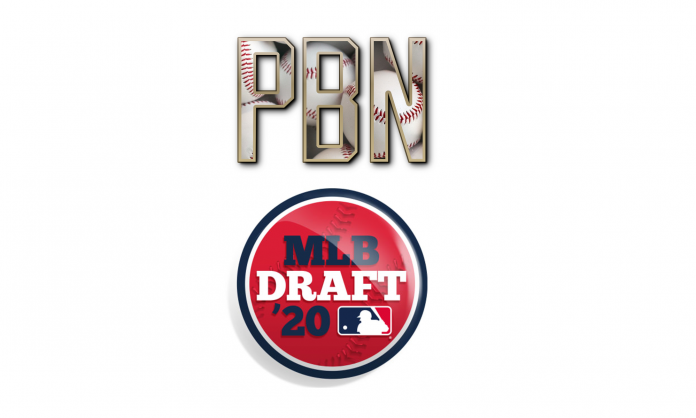The 2020 MLB draft will be held on June 10-11, and it will consist of five rounds. Teams will also be able to sign non-drafted players for a maximum $20,000 bonus.
The Pittsburgh Pirates own the seventh overall pick in this draft, as well as the 31st and 44th overall picks. Their draft bonus pool for five rounds was announced last month (that link has been updated since the Red Sox lost their second round draft pick). Each Saturday, we have been taking an in depth look at draft prospects who could be a good fit for that seventh overall pick, as well as players who fits better with those two lower picks. We have run out of guys who have been mentioned near the seventh pick, but we still have plenty of options for the two lower picks. In case you missed it, here’s our draft preview article.
We have posted 17 Draft Prospect Watch articles so far, which are all linked here:
Nick Gonzales and Jordan Westburg
Asa Lacy, JT Ginn and Emerson Hancock
Garrett Mitchell and Freddy Zamora
Austin Wells and Patrick Bailey
Tyler Soderstrom and Drew Romo
Heston Kjerstad and Daniel Cabrera
Robert Hassell and Pete Crow-Armstrong
Carson Montgomery and Tanner Witt
Austin Hendrick and Garrett Crochet
Dillon Dingler and Casey Martin
Today we look at two of the top ranked players who haven’t been covered here yet. Jonathan Mayo recently released a mock draft on MLB Pipeline in which he had Georgia right-handed pitcher Cole Wilcox going 20th overall and Texas Tech right-handed pitcher Clayton Beeter going in the 28th spot. It’s possible that both of these players are an option when the Pirates pick 31st overall and both of them are intriguing players.
Wilcox was highly rated coming out of high school and now he’s eligible as a sophomore, who turns 21 shortly after the draft. We briefly covered him here during our 2018 draft coverage. He has filled out his 6’5″ frame a lot in two years at college (now up to 232 pounds) and was just starting to show some big results when play was halted this year. He had a 1.57 ERA in 23 innings, with a 32:2 SO/BB ratio. The walks are impressive because he was not throwing enough strikes as a freshman last year.
Wilcox has a fastball that has touched 100 MPH at times, with 97-98 MPH frequently seen on the gun. He was sitting mid-90s with some movement after switching from relief to starter. Baseball America notes that his mid-80s slider is a plus pitch, while his mid-80s changeup shows nice separation. Both pitches get a 55 grade from MLB Pipeline.
You’re looking at a workhorse frame here, with a plus fastball and three above average pitches. The only question here that wasn’t completely answered is the control issues from 2019. The results were great in that department this year, but 23 innings in still a relatively small sample size and he didn’t get into the conference schedule yet, which is where he had most of his issues last year. Being a draft-eligible sophomore, he has a bit more leverage than most, which could cause him to drop in the rankings.
Here’s a video of his strikeout pitches from this year. The off-speed pitches start halfway through, once he’s done overpowering guys with the fastball
Clayton Beeter is more likely to be available if Wilcox doesn’t drop to 31st overall. In fact, there’s a bit of a disagreement on his prospect status, with Baseball America actually ranking him 80th overall in this draft class, while Pipeline has him 51st overall, though he’s been mentioned by scouts as a late first round possibility.
Beeter is a draft-eligible sophomore, though with a little less leverage than Wilcox. That’s because he missed his freshman year due to Tommy John surgery, so he was a redshirt freshman last year and he turns 22 later this year. He also has a similar story to Wilcox, where he had trouble throwing enough strikes as a freshman reliever last year, but he turned that around in a small sample size this year as a starter. Beeter had a 2.14 ERA in 21 innings when play stopped, with a 33:4 SO/BB ratio.
As for the stuff, he’s working with a mid-90s fastball that touched 98 MPH as a starter this year. He actually saw a rise in velocity while moving from relief to starter, which is a great sign. He has two breaking ball that get great reports. BA calls his curve a hammer pitch, while Pipeline believes his mid-80s slider might be his best offering. Since he offers three above average pitches, his changeup is a distant fourth pitch, though he does occasionally use it and he has a feel for the pitch.
Beeter doesn’t have the track record of Wilcox and there are some injury concerns with the Tommy John surgery and another minor elbow procedure in his past. He had a chance to really move up the draft charts if play continued, as he was trending in that direction. He has a 6’2″, 220 frame, with three plus pitches and he was showing improved control this season.
Here’s video of his 2020 strikeout pitches



